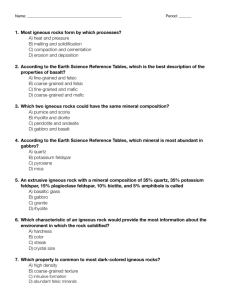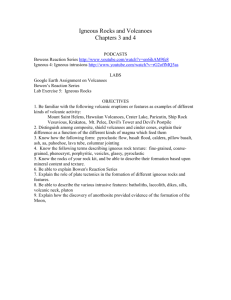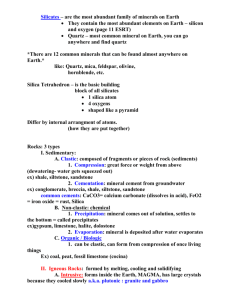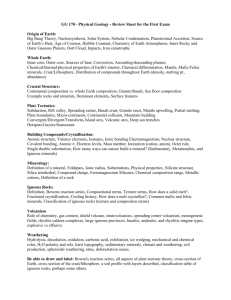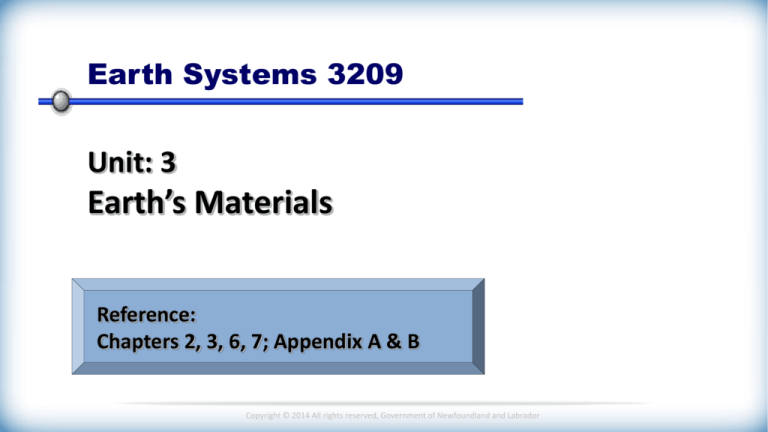
Earth Systems 3209
Unit: 3
Earth’s Materials
Reference:
Chapters 2, 3, 6, 7; Appendix A & B
Copyright © 2014 All rights reserved, Government of Newfoundland and Labrador
Unit 3:
Topic 3.4
Igneous Classification Chart
Focus on . . .
identifying the eight rock forming minerals.
describing the mineralogy associated with common
igneous rocks and relate to igneous compositions and
textures.
Copyright © 2014 All rights reserved, Government of Newfoundland and Labrador
Rock Forming Minerals
All Igneous rocks originally solidified from magma/lava.
Igneous rocks form from Eight minerals called the
rock forming minerals.
1) Olivine
5) Plagioclase Feldspar
2) Pyroxene
6) Orthoclase Feldspar
3) Amphibole
7) Muscovite Mica
4) Biotite Mica
8) Quartz
Copyright © 2014 All rights reserved, Government of Newfoundland and Labrador
Igneous Rocks
Type of Igneous rock formed depends on the
environment where it crystallizes.
Two main environments:
1) Volcanic
Molten rock cools on or near Earth’s surface
which results in very small crystals.
2) Plutonic
Molten rock cools beneath Earth’s surface
which results in larger more uniform sized
crystals.
Copyright © 2014 All rights reserved, Government of Newfoundland and Labrador
Text Reference:
Pages 61-73
Volcanic Igneous Rocks
Rhyolite:
Quartz and Orthoclase feldspar
Light in color ( < 15% dark minerals)
Microscopic crystals (fine texture)
Rocks become darker in color
Rock Types
Composition
Felsic
Intermediate
Mafic
Ultramafic
Volcanic
Rholite
Andesite
Basalt
Komatotite
Plutonic
Granite
Diorite
Gabbro
Peridotite
Copyright © 2014 All rights reserved, Government of Newfoundland and Labrador
Volcanic Igneous Rocks
Andesite:
Amphibole and Plagioclase feldspar
Medium colored ( < 40% dark Minerals)
Microscopic crystals (fine texture)
Rocks become darker in color
Rock Types
Composition
Felsic
Intermediate
Mafic
Ultramafic
Volcanic
Rholite
Andesite
Basalt
Komatotite
Plutonic
Granite
Diorite
Gabbro
Peridotite
Copyright © 2014 All rights reserved, Government of Newfoundland and Labrador
Volcanic Igneous Rocks
Basalt:
Pyroxene and Plagioclase feldspar
Dark in color ( > 40% dark minerals)
Microscopic crystals (fine texture)
Rocks become darker in color
Rock Types
Composition
Felsic
Intermediate
Mafic
Ultramafic
Volcanic
Rholite
Andesite
Basalt
Komatotite
Plutonic
Granite
Diorite
Gabbro
Peridotite
Copyright © 2014 All rights reserved, Government of Newfoundland and Labrador
Plutonic Igneous Rocks
Gabbro:
Pyroxene and Plagioclase feldspar
Dark in color ( > 40% dark minerals)
Visible crystals (coarse texture)
Rocks become darker in color
Rock Types
Composition
Felsic
Intermediate
Mafic
Ultramafic
Volcanic
Rholite
Andesite
Basalt
Komatotite
Plutonic
Granite
Diorite
Gabbro
Peridotite
Copyright © 2014 All rights reserved, Government of Newfoundland and Labrador
Plutonic Igneous Rocks
Diorite:
Amphibole and Plagioclase feldspar
Medium colored ( < 40% dark Minerals)
Visible crystals (coarse texture)
Rocks become darker in color
Rock Types
Composition
Felsic
Intermediate
Mafic
Ultramafic
Volcanic
Rholite
Andesite
Basalt
Komatotite
Plutonic
Granite
Diorite
Gabbro
Peridotite
Copyright © 2014 All rights reserved, Government of Newfoundland and Labrador
Plutonic Igneous Rocks
Granite:
Quartz and Orthoclase feldspar
Light in color ( < 15% dark minerals)
Visible crystals (coarse texture)
Rocks become darker in color
Rock Types
Composition
Felsic
Intermediate
Mafic
Ultramafic
Volcanic
Rholite
Andesite
Basalt
Komatotite
Plutonic
Granite
Diorite
Gabbro
Peridotite
Copyright © 2014 All rights reserved, Government of Newfoundland and Labrador
Classification of Igneous Rocks
A general classification scheme based on chemical composition and
texture is provided in the following diagram.
Composition
Felsic (Granitic)
Intermediate (Andesitic)
Mafic (Basaltic)
Quartz
Orthoclase
Feldspar
Amphibole
Feldspars
Pyroxene
Plagioclase
Feldspar
Light
Medium
Dark
Coarse
Grained
Granite
Diorite
Gabbro
Fine Grained
Rhyolite
Andesite
Basalt
Vesicular
Pumice
Major Minerals
Color
T
E
X
T
U
R
E
(frothy glass)
Glassy
Obsidian
(compact glass)
Copyright © 2014 All rights reserved, Government of Newfoundland and Labrador
Scoria
Classification of Igneous Rocks
Overview of topics:
Rock Forming Minerals:
Composition;
1) Felsic
2) Intermediate
3) Mafic
Environment (Texture);
1) Intrusive (Plutonic)
2) Extrusive (Volcanic)
Copyright © 2014 All rights reserved, Government of Newfoundland and Labrador
Classification of Igneous Rocks
Questions:
1) What minerals would be found in an
average composition of Granite?
Basalt?
Copyright © 2014 All rights reserved, Government of Newfoundland and Labrador
Classification of Igneous Rocks
Questions:
2) What minerals would be found in
most all igneous rocks?
Copyright © 2014 All rights reserved, Government of Newfoundland and Labrador
Classification of Igneous Rocks
Questions:
3) What minerals would you never find in;
i) Felsic igneous rocks?
ii) Mafic igneous rocks?
Copyright © 2014 All rights reserved, Government of Newfoundland and Labrador
Example 1:
Using the diagram below, answer the following questions:
What is the volcanic equivalent of a rock
that has 55% plagioclase feldspar, 25%
hornblende and 20% pyroxene?
(A) andesite
(B) basalt
(C) komatiite
(D) rhyolite
Based on the diagram, which mineral is
found in most igneous rocks?
(A) plagioclase feldspar (B) biotite
(C) potassium feldspar
(D) olivine
Copyright © 2014 All rights reserved, Government of Newfoundland and Labrador
Example 2:
What characteristic allows two igneous rocks with the
same mineral composition to have different names?
(A) colour
(B) foliation
(C) shape
(D) texture
Which intrusive/extrusive pair of rocks have the same
mineral composition?
(A) basalt/andesite
(B) gabbro/basalt
(C) granite/diorite
(D) granite/andesite
Copyright © 2014 All rights reserved, Government of Newfoundland and Labrador
Your Turn . . .
Take the time and complete the following questions . . .
(Solutions to follow)
Question:
Explain why two igneous rocks can have
the same mineral composition, but have
different rock names.
Copyright © 2014 All rights reserved, Government of Newfoundland and Labrador
Solutions . . .
Answer:
The type of Igneous rock not only depends on its mineral
composition, but also, on the environment in which the molten rock
crystallized. The environment will determine the texture of the rock,
which is another factor used to classify (Name) igneous rocks.
Thus, two igneous rocks with the same mineral composition and
have different textures, will have different names.
For Example;
Rhyolite and Granite (Felsic composition)
Andesite and Diorite (Intermediate composition)
Basalt and Gabbro (Mafic composition)
Copyright © 2014 All rights reserved, Government of Newfoundland and Labrador
Summary . . .
Overview of Points covered:
Classification of common Igneous Rocks:
Felsic – Granite/Rhyolite
Same
Composition:
Intermediate – Diorite/Andesite
Same
Texture:
Fine – Rhyolite/Andesite/Basalt
Mafic – Gabbro/ Basalt
Coarse – Granite/Diorite/Gabbro
Copyright © 2014 All rights reserved, Government of Newfoundland and Labrador

